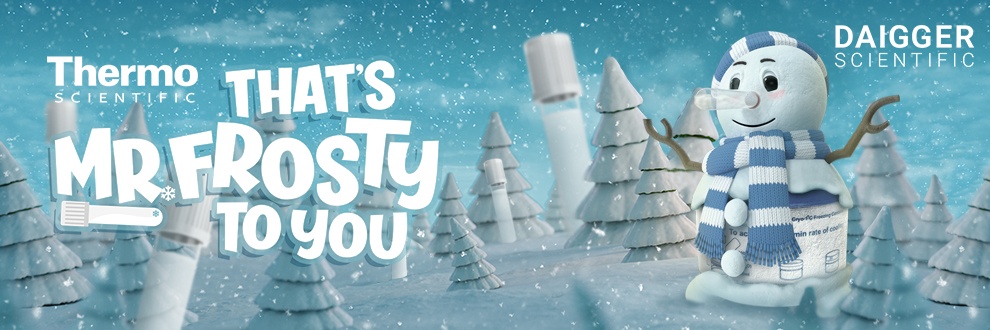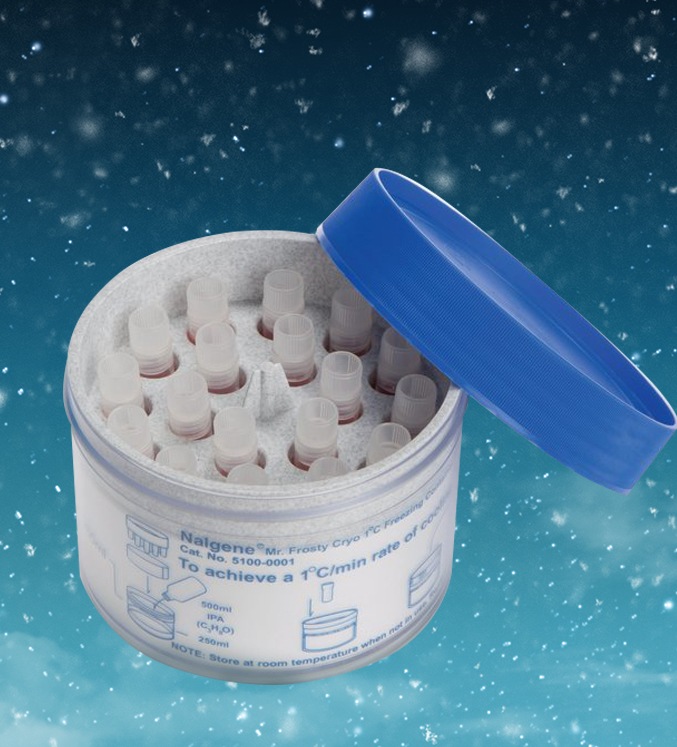Can you replace a controlled rate freezer with Mr Frosty cell freezing containers?

Clinical labs, hospitals, cell banks, and research institutes call for Mr Frosty by name in their standard operating procedures
How many cell samples have you lost because the cell freezing was too fast or too slow, or because an inexperienced colleague didn’t prepare or store or label the sample correctly?
Your lab can fix that problem for less than $120. You won’t have to supervise inexperienced colleagues to make sure cell samples are cooled, frozen, and preserved properly. If they can pour isopropyl alcohol into a vessel, they can prepare your samples for cryopreservation perfectly.
Save your cell samples from inexperienced colleagues for less than $120
Even workers on their first day can freeze cell samples unsupervised without damaging them
Cool samples at very close to -1°C per minute with Nalgene Mr Frosty and your ultra-low temperature freezer, then transfer the 1mL - 5mL cryotubes to simple Nalgene colored cryoboxes for long term storage.

Replace the antique styrofoam blocks your lab uses for cell freezing
Nalgene Mr Frosty freezing containers are the preferred solution for small sample storage.
And they're a VERY affordable alternative to a controlled-rate freezer.
For professionals in every state, it was love at frost sight with affordable Mr Frosty cell freezing containers.
They're ideal for:
- Universities
- Hospitals
- Research institutions
- Cell banks
- Clinical labs
Confidently preserve your most precious samples
The Nalgene Mr Frosty Freezing Container cryopreservation and storage solution offers scientists outstanding temperature performance at low operating costs.
Common applications include:
- Cryo storage of reproductive tissues in the in vitro fertilization laboratory
- Freezing plant cells
- Protoplast
- PBMC (peripheral blood mononuclear cell)
And more. Safely and confidently preserve your most precious cell and biological samples.
All the features you need for small sample storage
The Thermo Scientific Nalgene Mr Frosty Freezing Container provides the critical, repeatable -1ºC/minute cooling rate required for successful cell cryopreservation and recovery.
The polycarbonate container with screw lid, foam liner and rigid polyethylene vial holder requires only 100% isopropyl alcohol and a mechanical freezer for cooling. A foam insert keeps vials from contacting the alcohol and can be floated in a water bath during thawing. Molded numbers on the containers identify vials.
Key features include
- Repeatable 1ºC/minute cooling for preserving cells
- Graphic, step-by-step instructions on container
- Stackable for easy storage
- Each "Mr Frosty" container holds eighteen 1.2-2.0 mL vials. 3 7/16" H x 4 5/8" dia. size.

The top five reasons users love Mr Frosty storage containers are...
The pr-ice is right: You can buy 100 of these compact, cost-effective containers for the same price as a cheap controlled rate freezer that will last you a couple years, max.
They’re built to keep your samples safe: The super simple-to-use system, designed to achieve a rate of cooling close to -1°C/minute (the optimal rate for cell preservation)
Save precious freezer space during the cooling process: Nalgene Mr Frosty storage containers hold 12 - 18 tubes, are easily stackable, and take up far less workspace than controlled-rate freezers
Accidents happen. Mr Frosty gets ahead of them: Screw top lid secures samples inside in the event of accidental container tipping (it happens to the best of us)
Super simple-to-use-system: Even for new users! Eliminates unreliable, improvised foam container devices, and requires only 100% isopropyl alcohol and a mechanical freezer. Plus there’s no contact with the alcohol: no wicking, no label removal and no compromise of tube hand printing.
It was love at frost sight for this user...
“We have found them very useful in our labs. They give you a 1 degree per minute drop in a minus 70-80 freezer. They are a lot cheaper than the liquid nitrogen-based cell freezers and just as effective, for smaller batches of cells that is.”
What’s the starting temperature for a Mr Frosty cell freezing container?
With this freezing container, there's no need to stand at room temperature for long stretches of time. Samples can move immediately from room temperature to the -80°C freezer and immediately begin a controlled reduction in temperature.
One user shares: "We routinely freeze hybridoma cells using DMSO and the time it takes to fill the Mr Frosty cell freezing container and walk to the -80 freezer (about 4-5 minutes) seems enough. We always get greater than 90% cell viability on recovery."
All about cryopreservation
Cryopreservation is the preservation of cells and tissues by freezing. In day-to-day medicine and research, freezing is an extremely useful method of storing living cells, including blood cells, sperm cryopreservation, and embryo cryopreservation, and bone marrow, at ultra-low temperatures.
Most systems of cellular cryopreservation use a controlled-rate freezer, which delivers liquid nitrogen in an enclosed chamber, into which the cell suspension is placed. Careful monitoring of the rate of freezing can help prevent rapid cell dehydration and ice crystal formation.
Biological cells can live for more than a decade if frozen properly. Certain tissues, like veins, cardiac valves, parathyroid glands, and aortic tissues, can also be cryopreserved. Additionally, cryopreservation is used to store and maintain the long-time viability of early human embryos, ova, and sperm.
The origins of cryostorage
Cryopreservation allows for storage of biological samples at low temperatures.
While technological advances have helped us come a long way, it’s long been known that biological materials can be preserved longer at lower temperatures. Archeologists have found that ice houses were used as early as 2000 BC, throughout Mesopotamia to store foods. In the 17th Century, Boyle and other scientists
studied the ability of ice to preserve human bodies, and even made attempts to freeze and revive live animals.
These preservative effects rely on depriving biological samples of thermal energy that’s required for normal molecular motion and metabolism, which slows the cell’s decomposition. In the 20th Century, cryogenic technologies enabled us to reliably generate extremely low temperatures (often below 100 C). In 1940,
cryoprotective agents (known as cryoprotectants) were discovered, which lead the way towards even more advances towards cryopreservation.
Cryopreservation means the ability for small molecules to enter cells and prevent dehydration and the formation of intracellular ice crystals.
The cryoprotective agent used depends on your biological samples. The two most common agents are:
- Glycerol: used primarily for cryoprotection of red blood cells
- Dimethyl sulfoxide (DMSO): Used in the preservation of most other cells and tissues
Today, cryopreservation is used throughout biological, medical, and research fields to store living cells and tissues.
Common clinical applications for cryopreservation
Cryopreservation is now widely used in science, research, and biomedicine, including in organ transplantation, regenerative medicine, and drug discovery.
A few common applications for cryopreservation include:
- Cryopreservation is important in organ and tissue banking, and plays an essential role to meet ‘ready to use’ requirements in clinical applications and regenerative medicine
- Cryopreservation is also an essential component of fertility treatment, and used to store human embryos, ova and ovarian tissue, and sperm. Reproductive tissues need to be harvested before treatment is initiated, and has to be stored safely until treatment is completed. This is especially valuable for egg freezing and generating extra frozen embryos generated by IVF (in vitro fertilization)
- Another important application of cryopreservation is freezing and storing hematopoietic stem cells, found in peripheral blood and bone marrow.
Mr Frosty came, thaw, and conquered
Nalgene Mr Frosty freezing containers are snow joke. If you’re looking for a reliable, affordable, cell preservation solution, and a freezing medium that takes up less space and less of your budget, don’t think tw-ice about placing your order.